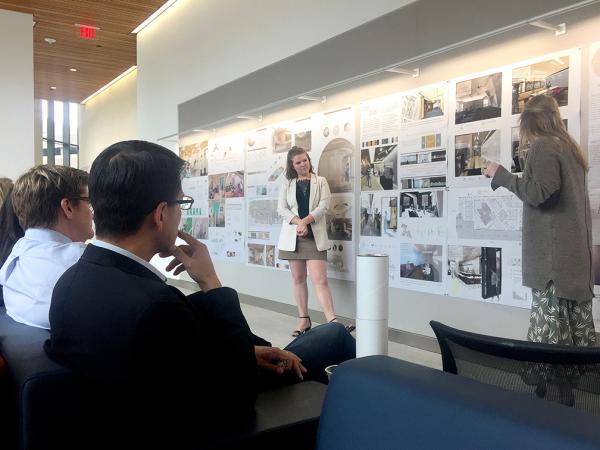Designing for Young Adults: Students Collaborate with Design Institute for Health

Dell Medical School at The University of Texas at Austin is redefining health education—but not just for its own students. This past semester, it served as a gateway for students from the UT Austin School of Architecture to learn about designing environments to support health and well-being. An upper-division interior design studio housed in Goldsmith Hall worked closely with teams from the medical school's Design Institute for Health and LIVESTRONG Cancer Institutes, a partnership with the LIVESTRONG Foundation, to generate ideas for a new type of cancer center for young adults—a challenge that the students were uniquely positioned to address for their peers.
“This studio not only helped me understand others better but also myself. I learned that my future career path is remarkably meaningful and it has a unique gift to bring comfort, hope, health, and joy to others through the creation of built environments.” —Alexandra Wilkinson, Bachelor of Science in Interior Design Candidate, Class of 2019
Advancements in medicine are allowing cancer patients to live longer, giving rise to the demand for specialized centers. The semester-long project led by Associate Professor and Interior Design Program Director Tamie Glass and lecturer Marla Smith focused on creating concepts for a prototypical new cancer care environment for patients in their late teens to mid-thirties. Rebekkah Schear, Associate Director for Patient Experience at the LIVESTRONG Cancer Institutes, played an integral role in helping students understand the needs and aspirations of various stakeholders. She is guiding efforts to bring a new facility with an emphasis on young adults to Austin in the near future. Also lending expertise from the Design Institute for Health were Executive Director Stacey Chang and Director of Business and Behavior Design Charu Juneja.
At the beginning of the semester, students participated in an empathy-building simulation exercise and later met members of a local adolescent and young adult advisory (AYA) group who participated in reviews of their work. The studio toured innovative new spaces designed by the Design Institute for Health and an existing infusion center, while also reviewing current research and precedents to inform their concepts. The brief asked students to tackle this real-world problem and embrace the complexities of human-centered design. For instance, students explored creating graphics and environmental identities that will resonate with young adults, designing supportive spaces that can help promote community and positive health outcomes, and addressing needs for the range of individuals who will occupy the center—from patients and their friends and family to specially-trained care providers. A significant driver was considering the "fear of missing out," which is a common social anxiety that many young adults experience, especially AYA patients. To combat this, students envisioned spaces that their friends would want to visit and that capture the essence of Austin.
"I found it to be particularly memorable to interact with AYA cancer survivors, especially when we received their feedback during design reviews. Hearing what they had to say—whether positive or constructive—really helped solidify the direction of our concept." —Ana Berthelsen, Bachelor of Science in Interior Design Candidate, Class of 2019
Ultimately, the studio's role was to leverage the discovery and design process to question, inspire, and imagine a new type of center that distinguishes itself from those specializing in pediatric and adult care. The studio resulted in five distinct proposals, which were developed in teams over the course of the 16-week semester. Beyond providing a rich educational experience for the students, the studio’s insights will be instrumental to the LIVESTRONG Cancer Institutes in envisioning future place-based initiatives for the adolescent and young adult community in central Texas.
“I was awe struck by the talent of these students and care they have taken to think through so many steps of the clinic process for AYAs. This is going to be so helpful for our design and I know that we will capture concepts from all of them.” —Dr. Gail Eckhardt, Professor and Chair, Department of Oncology, Director, LIVESTRONG Cancer Institutes, Dell Medical School
The following students participated in ARI Design 6 / Technical Studio:
Helena Aguirre
Annely Alaniz
Ana Berthelsen
Juliette Fray
Jacqueline Gay
Shruti Iyer
Emily Kaplan
Katherine Kligerman
Taylor Mahnke
Adina Schunicht
Alexandra Wilkinson

